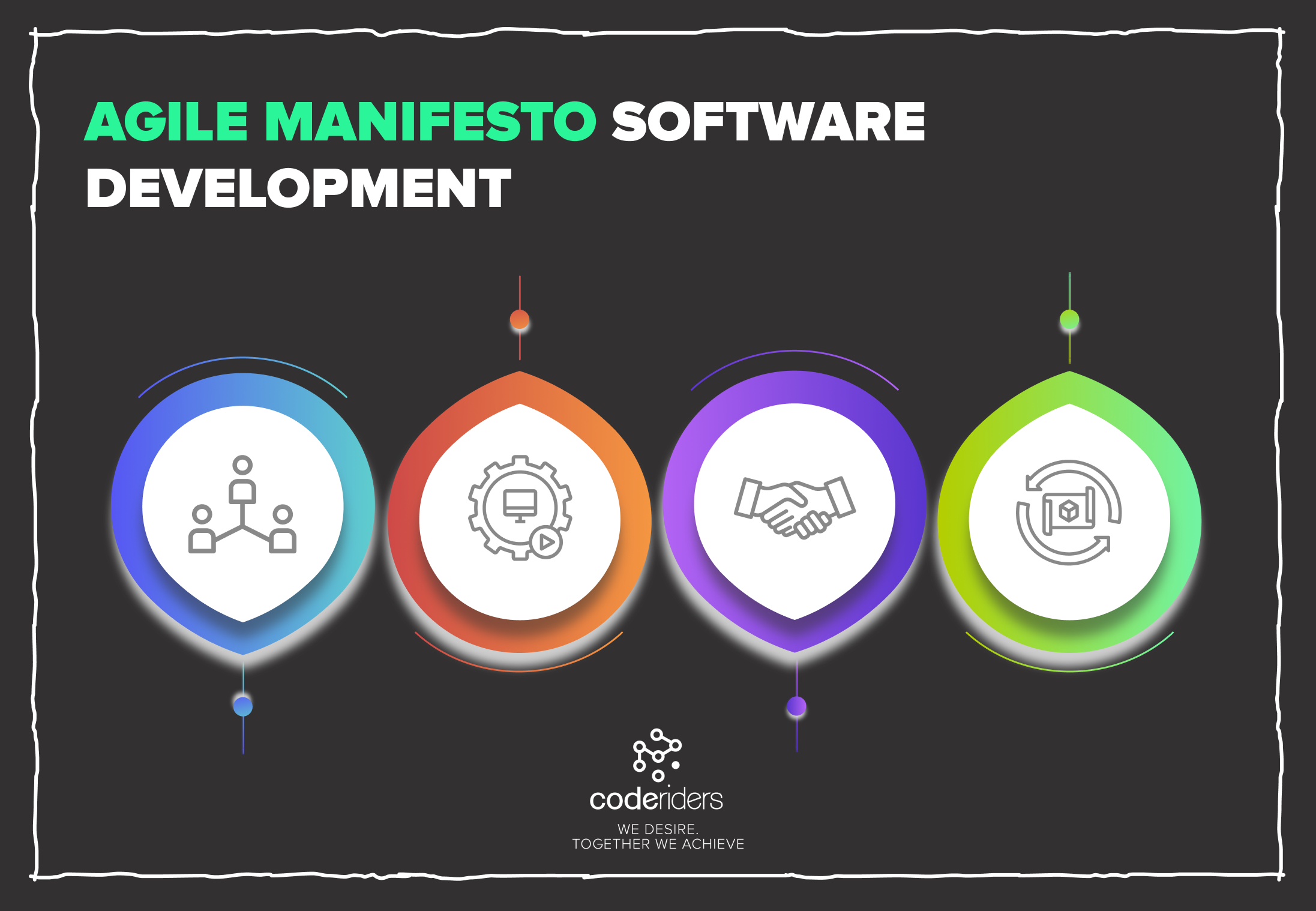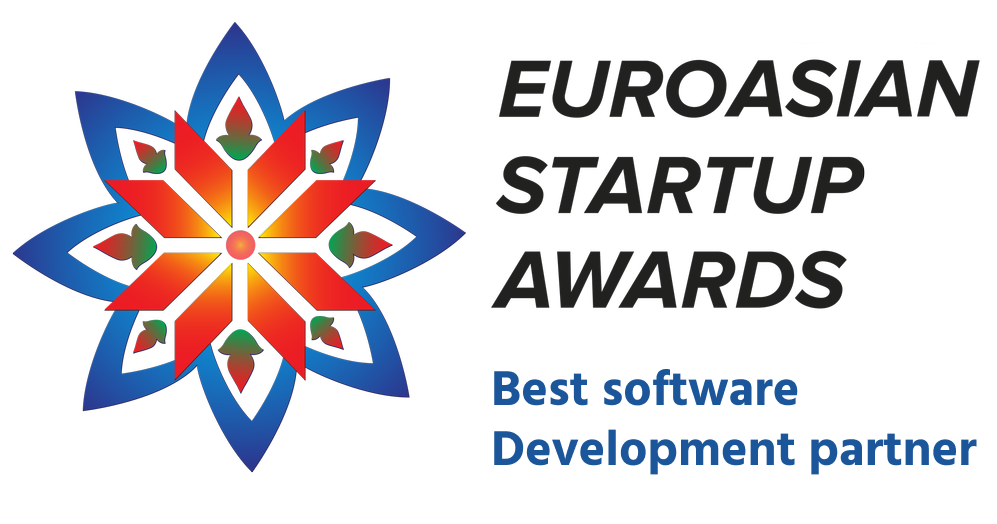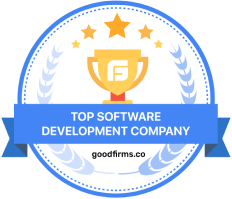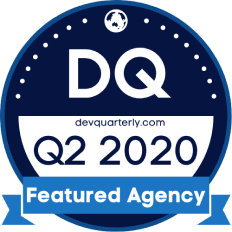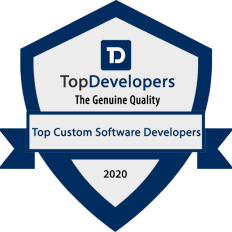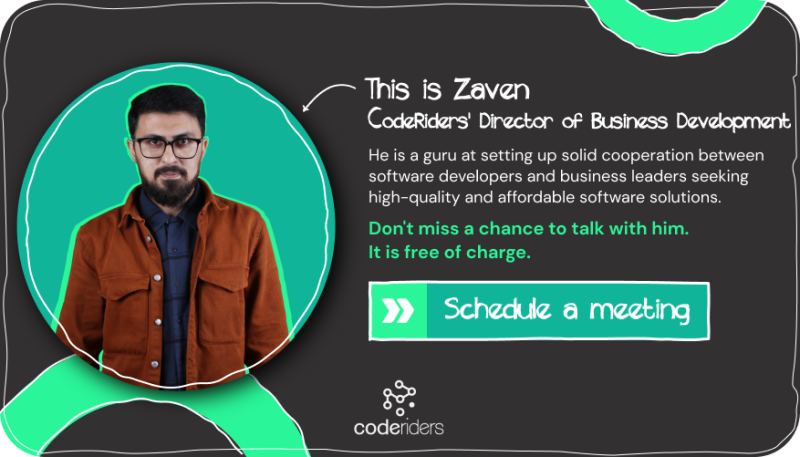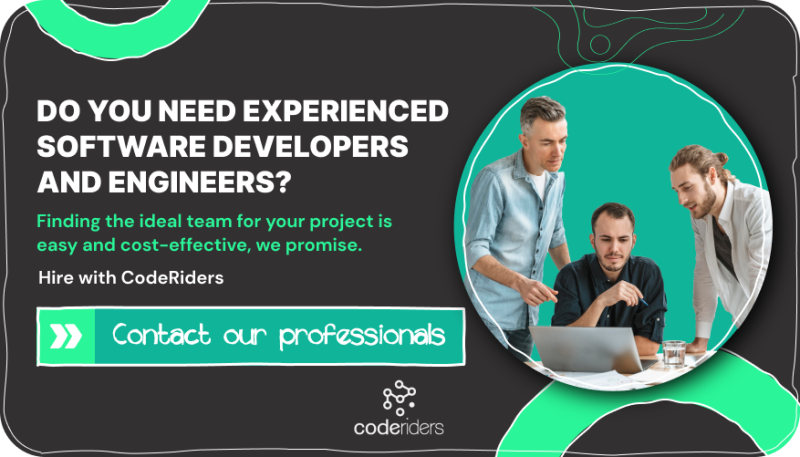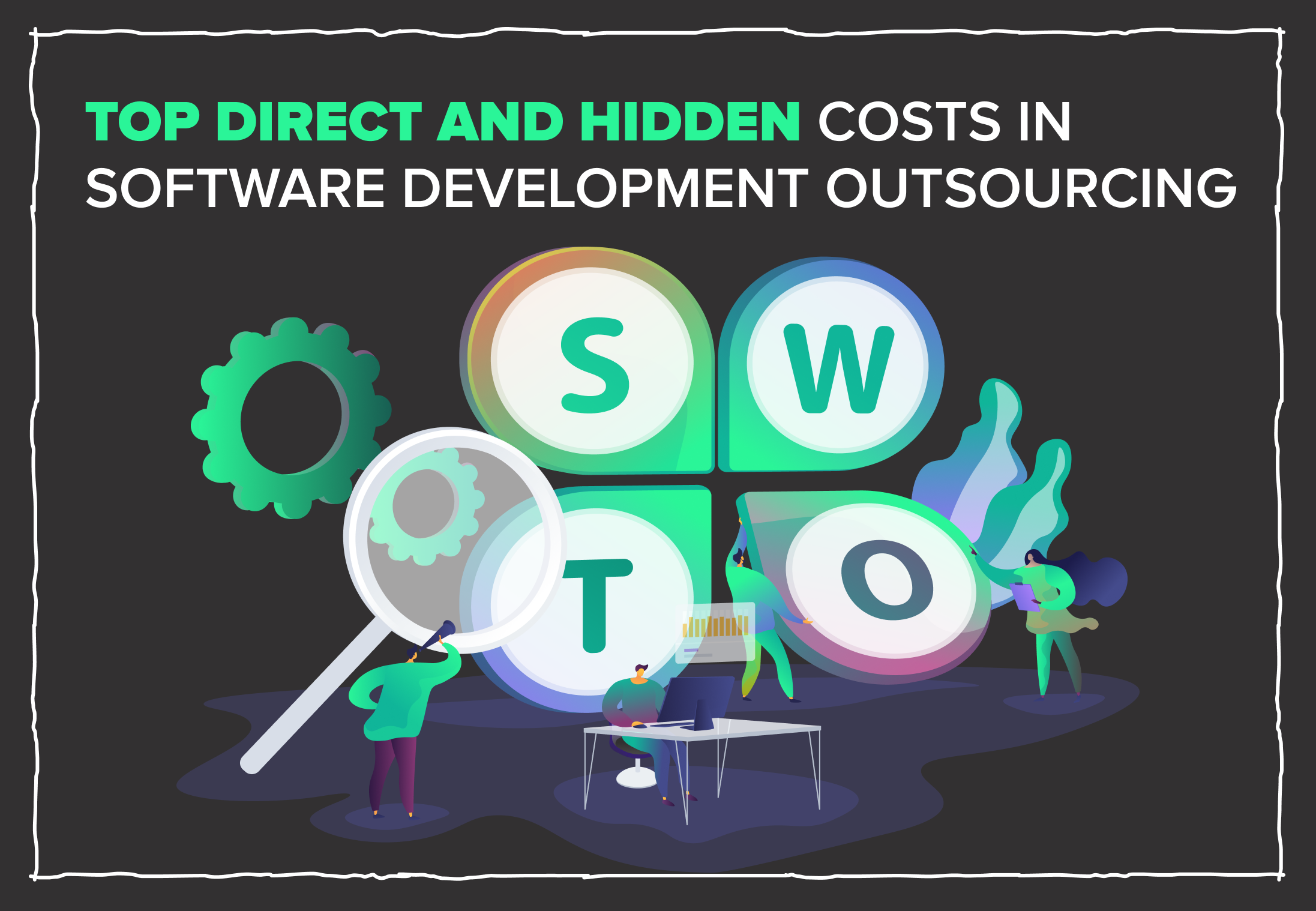The agile software development methodology is a flexible approach to the software development process. Agile software development companies use interactive methods of delivering software products in pieces (continuous MVP releases), incorporating stakeholder feedback.
It is a flexible methodology helping tech teams deliver high-quality software development services faster and with minimum complications.
The first Agile software development philosophy was popular among small and self-controlled teams. Eventually, Agile software development took over the software development industry because of its easiness, productiveness, and effectiveness.
In Agile, the software development team delivers the project through iterations. Unlike the Waterfall methodology, which follows a specific path and there are minimum deviations from them, Agile stands out with its velocity and adaptability. The team members and stakeholders are free to make changes during the iterations.
In today’s rapidly growing and competitive economy, flexible and adjustable Agile iterations are perfect.
This article is a compressed version of CodeRiders’ guide to Agile software development. At CodeRiders, we have created a complete practical guide to Agile software development. In the end, you will also find the top 6 most exposing questions to ask Agile software development companies. The answers will identify if your future software vendor is a good fit for your project. Once the guide is available, we will insert the downloadable link below.
Continue reading this article if you need a quick introduction.
Agile Software Development Principles, Patterns, and Practices
4 Agile Values
In 2001, a group of software managers and stakeholders gathered to think of ways to make SDLC better. In this gathering, they produced the 4 values and 12 principles of Agile.
Here are the all-time famous 4 Agile values:
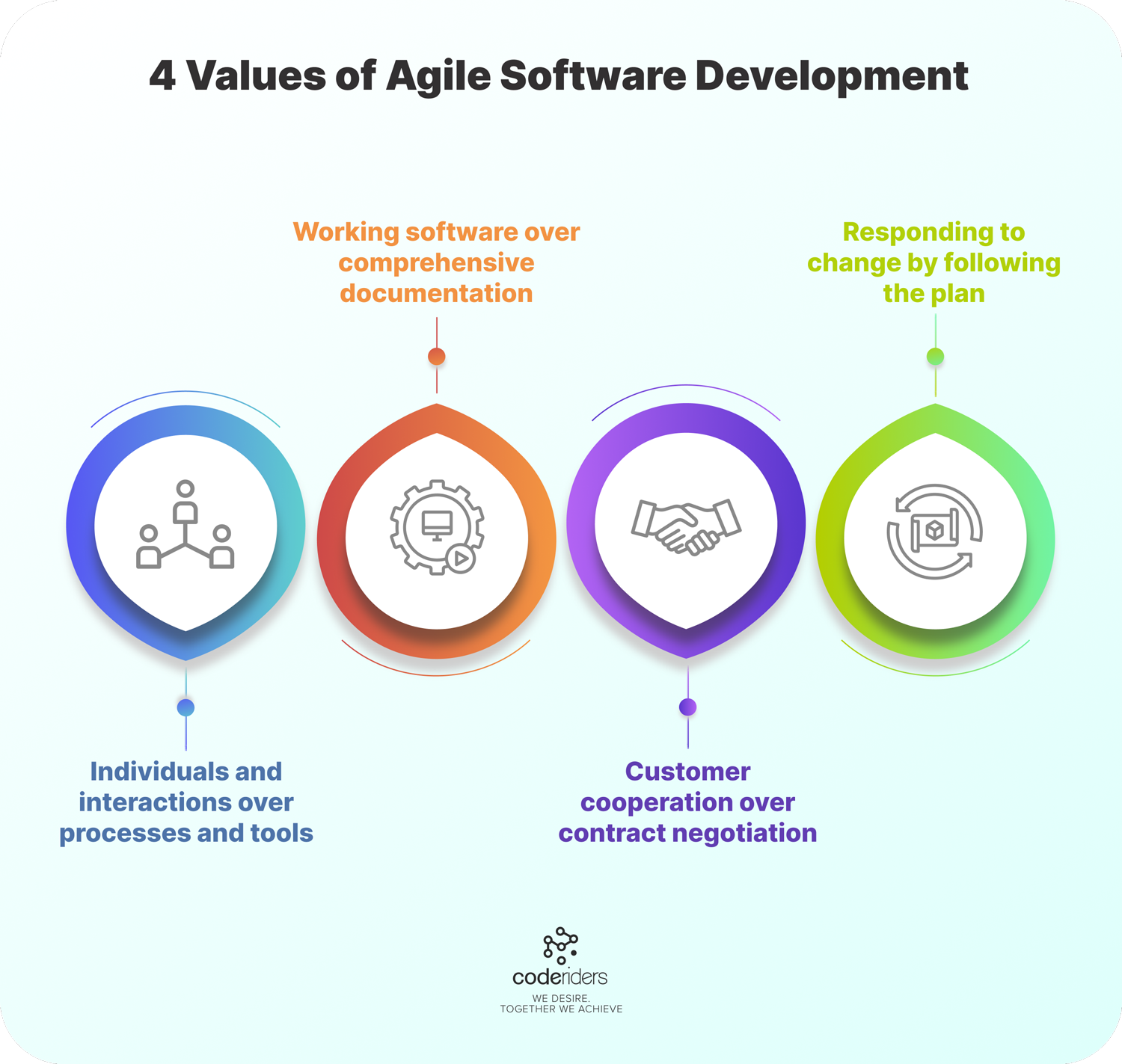
1. Individuals and interactions over processes and tools
This value highlights the relationship of team members over the processes or tools used by the software vendor and the stakeholder. For example, we have 2 software developers in the team, and they need to interact or share information to complete and deliver a specific software solution. In Agile, we do not care which technologies, tools, or methods software developers use for a successful interaction. What we do care about is the simple way of information delivery from one team member to the other.
As you may have already noticed, the 4 Agile values favor one merit over another. These may sometimes remind us of the Agile vs Waterfall comparison.
Subscribe to Newsletters
2. Working software over comprehensive documentation
In sequential software outsourcing lifecycles like Waterfall, we go through a lot of documentation before starting the software outsourcing partnership. Some of these documents include SRS or the user requirements document, sequence diagrams, UML diagrams, etc. In Agile, the most important thing is working software instead of comprehensive documentation.
For example, in Agile, you do not need to document all the login functionality requirements before starting the actual development process. Agile software development companies will put the stress on having a working and bug-free login functionality inside custom software. Of course, this does not mean we will not have any type of documentation. The idea of this approach is to prioritize the actual functionality rather than the documentation.
To help our clients review an example of an SOW document, at CodeRiders, we made a simple guide to writing a candid SOW document with a real sample. You can download it below.
free white paper
how to write a solid scope of work sow
3. Customer cooperation over contract negotiation
In the fixed-price software development engagement model (sequential software development processes), the two parties sign a contract with clear-cut tech documentation before starting the software outsourcing partnership. It means that if the stakeholder can not make changes after beginning the software outsourcing process. In Agile, the customer can approach the middle of the project and ask for some adjustments. The Agile software development company will accept the request and establish some kind of collaboration with the stakeholder. It does not mean that the software development team will build everything again from scratch, but they will collaborate with the stakeholder to build a product with the highest quality possible corresponding to the customers' requirements.
4. Responding to change by following the plan
In any software outsourcing project, we have a plan, which is important because it is the cornerstone of the project. In sequential software development models, like Waterfall, software developers and other tech team members are directed by the management team "to stick to the plan" but in Agile, it is the other way around. The plan is crucial to form a view of the future custom software. However, if the circumstances change during the SDLC and it is more beneficial to change the plan, Agile teams respond to change.
For example, the management team chooses one of the popular tools used in Agile software development, ex. Jira, Trello, and Asana, but after a while, they realize that the tool is not as effective as they thought. As Agile software development methodology values transparent SDLC, software quality, and flexible communication, the team will not hesitate to change the non-effective tool.
To sum up, the Agile Manifesto argues that if there is a contradiction between plan and change, Agile teams respond to change.
The Main Difference Between Agile and Waterfall or Any Sequential Development Models
Software development lifecycle: Waterfall vs Agile
In Waterfall projects, we have:
- Fixed requirements
- Clear-cut technical documentation
- Estimated time and resources
In Agile projects, we flip the values.
We have no fixed requirements, instead, we have fixed resources and time.
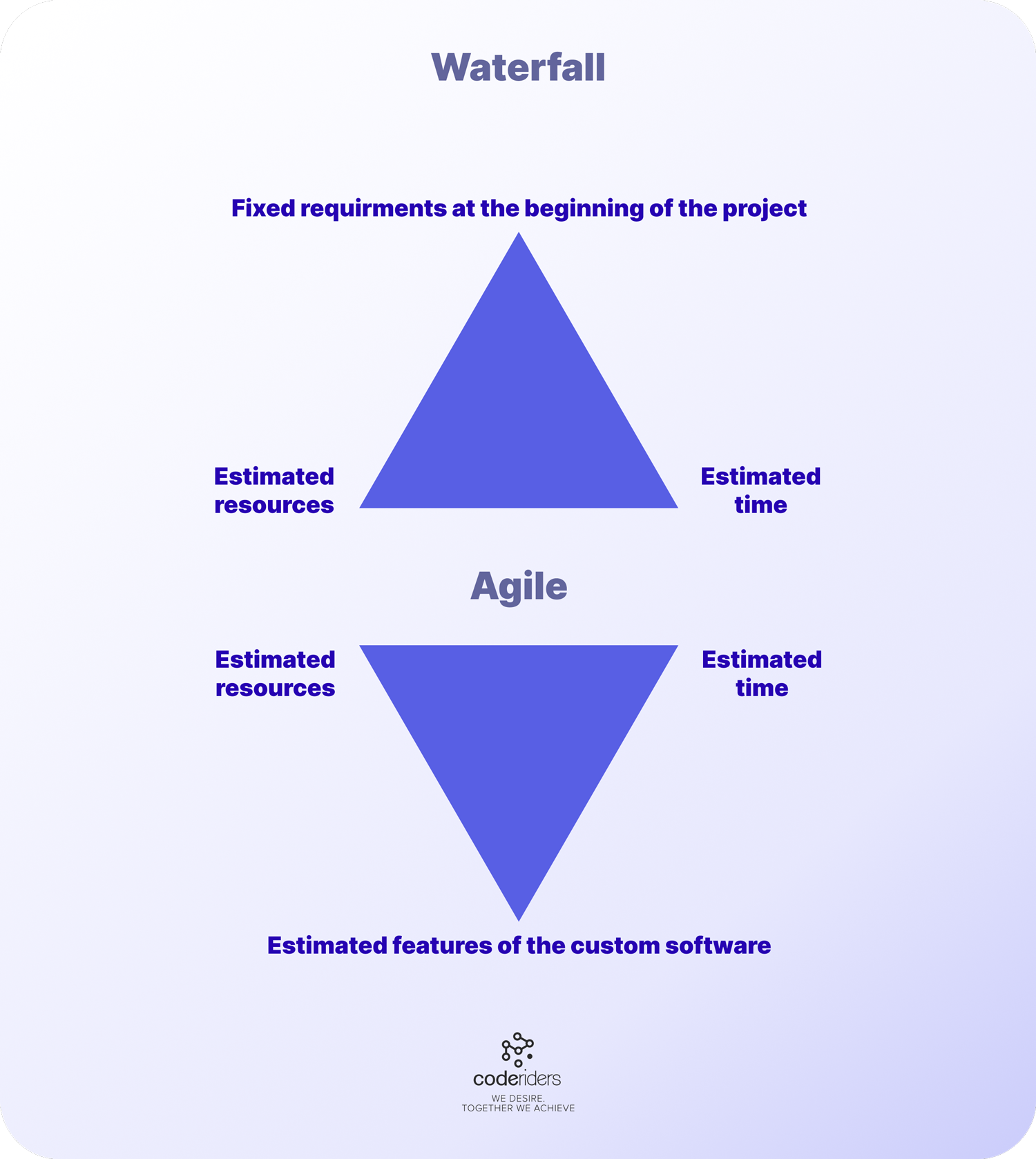
Project planning in Agile software development companies
1. Product vision: The team clearly defines the goal of their custom software. What problem does this software solve? How is it different from other similar software solutions? The product vision is created by the product owner and should be reviewed at least once a year if we speak about large and stable enterprises.
2. Product roadmap: The product roadmap, like the product vision, is a type of high-level planning. It is a high-level review of the product requirements that create the product vision. The product roadmap should be updated and reviewed at least twice a year.
3. Release planning: Release planning is also included in the high-level product planning however it is more specific than the product vision and the product roadmap. The product owner does the release planning by mentioning the release sequence and type of the product increments (versions) that should be released to the market. Release planning should be done at least quarterly.
Subscribe to Newsletters
4. Sprint planning: In Scrum, sprint planning is a collaborative activity between the Scrum team members, including the product owner. The Scrum team creates iteration goals, tasks, and deliverables and repeats the process every 1 to 4 weeks.
5. Daily Scrum: In Agile teams, the team members have daily stand-up meetings discussing current tasks that will help in reaching the iteration’s goal.
At the end of each iteration or sprint, Agile projects have 2 forms of planning:
- Sprint review: Sprint review includes the demonstration of the created product and is done by the product owner and the software development team at the end of every sprint.
- Sprint retrospective: Sprint retrospective meeting is organized to measure the progress of the team. During sprint retrospectives, Agile team members discuss processes and environments and make plans for process improvements in the next sprint.
Note: Not all Agile teams perform all of these project planning steps as it highly depends on the characteristic features of a specific software development project. The most popular plannings include sprint planning, retrospectives, sprint review, and daily Scrum. Startups or small teams also do not have a product vision or roadmap, however, it is advisable to have them beforehand.
How is the technical requirements documentation made in Agile software development methodology?
User requirements in Agile are written in a form that is called a “user story”.
User stories are written to capture requirements from the perspectives of software developers, testers (QA specialists), and business representatives. User stories must address both functional and non-functional characteristics.
Agile Methodologies
There are 3 most widely used and popular Agile software development methodologies. These are:
Scrum
What is Agile Scrum methodology? Succeeding with Agile software development using Scrum.
Scrum is an Agile project management framework that helps teams work together productively. Scrum describes a set of meetings, tools, and roles that work together to help teams structure and manage their work. In Scrum Agile methodology, the most widely used tool is JIRA Atlassian.
What is the Jira Scrum tool? Jira for Agile software development companies.
Jira software is a part of a family of products designed by Atlassian corporation to help teams of various sizes and types to manage and organize their work. Jira was created as a bug tracking tool but it eventually was expanded into a powerful work management tool for various purposes in SDLC, from requirements and test case management to agile software development.
Kanban
What is the Agile Kanban methodology? Succeeding with Agile software development using Kanban.
Kanban is a management approach that is sometimes used in Agile projects. The general objective of Kanban is to visualize and optimize the workflow within a value-added chain.
Kanban is not a traditional Agile approach like Scrum. Instead, it is used in work and task management in general. In Kanban methodology, the most popular tool is Trello.
What is Trello Kanban tool? Trello for Agile software development companies
Trello is a product of Atlassian like Jira. Thus, if you are already signed up on Jira, you can use the same credentials to sign up on Trello. Unlike Jira, which is based on Scrum, Trello is based on Kanban. It can be considered a Kanban board. Trello consists of separate boards. Trello provides templates for Agile project management, product management, and team management. Agile software development teams use any available Agile template to work with Agile principles and manage software development projects by iterations/sprints.
Extreme programming (XP)
XP is an Agile methodology that has been popular within software development teams since the 1990s. XP focuses not just on project management (like Scrum) but also on building the code. If Scrum focuses on work management, identifies specific roles in the project, and divides the project into iterations, XP focuses on software development and testing as well (not software development outsourcing management).
Subscribe to Newsletters
Here are the most important definitions of XP:
Quarterly cycle: Once a quarter, the XP team organizes meetings to do planning and reflection.
Weekly cycle: The weekly cycle practice is a one-week iteration in which the team chooses stories and builds working software that is "done" at the end of the week.
Both quarterly and weekly cycles are rarely used in Agile projects now. Most Agile teams now follow Scrum for project management: release – product backlog- sprint planning – sprint backlog.
Slack: Any time the team creates a plan, the team adds a slack by including a small number of optional or minor items.
To sum up, the Agile Manifesto is a widely-spread software development engagement model nowadays. It is used both during software development outsourcing as well as in-house software development processes. Agile Manifesto is ideal for a flexible software development lifecycle where change is preferred over a fixed plan, individuals and interactions are more important than processes and tools and working custom software is the goal rather than comprehensive software development documentation.
Having
development
needs?
CodeRiders will address your web and mobile development challenges by creating custom software, helping with outsourcing services, or just consulting on your software development requirements.



